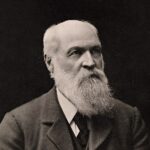
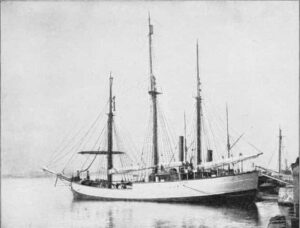 It’s strange to think that someone would build a ship for the sole purpose of freezing it in the Artic ice sheet as a way of “floating” it over the North Pole, but that was exactly the plan when a ship named Fram (meaning Forward) was designed and built by the Scottish-Norwegian shipwright Colin Archer. The ship was built for Fridtjof Nansen’s 1893 Arctic expedition, to actually freeze it in the polar ice. The ship was a special design to be used in expeditions of the Arctic and Antarctic regions by the Norwegian explorers Fridtjof Nansen, Otto Sverdrup, Oscar Wisting, and Roald Amundsen between 1893 and 1912. Nansen’s ambition was to explore the Arctic farther north than anyone else, but he knew that they would be dealing with a problem that many sailing on the polar ocean had encountered before him, a problem that ended their expeditions…the freezing ice could crush a ship and end the expedition. The ship that was going to survive freezing in the Artic ice sheet, would have to be different…in just about every way. Nansen’s idea was to build a ship that could survive the pressure of the ice, not because it was stronger, but because it’s very shape would let the ice push the ship up, so it would actually “float” on top of the ice.
It’s strange to think that someone would build a ship for the sole purpose of freezing it in the Artic ice sheet as a way of “floating” it over the North Pole, but that was exactly the plan when a ship named Fram (meaning Forward) was designed and built by the Scottish-Norwegian shipwright Colin Archer. The ship was built for Fridtjof Nansen’s 1893 Arctic expedition, to actually freeze it in the polar ice. The ship was a special design to be used in expeditions of the Arctic and Antarctic regions by the Norwegian explorers Fridtjof Nansen, Otto Sverdrup, Oscar Wisting, and Roald Amundsen between 1893 and 1912. Nansen’s ambition was to explore the Arctic farther north than anyone else, but he knew that they would be dealing with a problem that many sailing on the polar ocean had encountered before him, a problem that ended their expeditions…the freezing ice could crush a ship and end the expedition. The ship that was going to survive freezing in the Artic ice sheet, would have to be different…in just about every way. Nansen’s idea was to build a ship that could survive the pressure of the ice, not because it was stronger, but because it’s very shape would let the ice push the ship up, so it would actually “float” on top of the ice.
Fram is a three-masted schooner with a total length of 127 feet 11 inches and width of 36 feet 1 inch. The ship was designed to be both unusually wide and unusually shallow in order to better withstand the forces of pressing ice. By design it would be able to push up through the ice to the top of the ice sheet, thereby allowing  it to float. Fram’s outer layer was made of, which can withstand the ice. It also had almost no keel so it could handle the shallow waters Nansen expected to encounter. The ship was designed with a retractable rudder and propeller, and it was carefully insulated to allow the crew to live on board for up to five years. A windmill was installed to run a generator that would provide electric power for lighting by electric arc lamps. The ship was launched on 26 October 1892. During the initial building process, Fram was fitted with a steam engine, which was fine, until something better came along. Then, before Amundsen’s expedition to the South Pole in 1910, the engine was replaced with a diesel engine, a first for polar exploration vessels.
it to float. Fram’s outer layer was made of, which can withstand the ice. It also had almost no keel so it could handle the shallow waters Nansen expected to encounter. The ship was designed with a retractable rudder and propeller, and it was carefully insulated to allow the crew to live on board for up to five years. A windmill was installed to run a generator that would provide electric power for lighting by electric arc lamps. The ship was launched on 26 October 1892. During the initial building process, Fram was fitted with a steam engine, which was fine, until something better came along. Then, before Amundsen’s expedition to the South Pole in 1910, the engine was replaced with a diesel engine, a first for polar exploration vessels.
Because of wreckage found at Greenland from USS Jeannette, which was lost off Siberia, and driftwood found in the regions of Svalbard and Greenland, Nansen had a theory that an ocean current flowed beneath the Arctic ice sheet from east to west, bringing driftwood from the Siberian region to Svalbard and further west. That was the main reason for building Fram. He wanted to order to explore this theory. His expedition ended up lasting three years, during which time, Nansen realized that Fram would not reach the North Pole directly. The current either wasn’t strong enough, or the polar ice was actually on land at the North Pole. So, he and Hjalmar Johansen set out to reach it on skis. After reaching 86° 14′ north, he had to turn back to spend the winter at Franz Joseph Land. During their expedition, Nansen and Johansen survived on walrus and polar bear meat and blubber. Finally, after they met up with British explorers from the Jackson-Harmsworth Expedition, they arrived back in Norway only days before the Fram also returned there. Their skiing mission was far more successful than the Fram’s mission, as the ship had spent nearly three years trapped in the ice, after only reaching 85° 57′ N. Fram made a scientific expedition to the Canadian Artic Archipelago between 1892 and 1902, and after being fitted with the diesel engine, Amundsen made his South Pole expedition from 1910 to 1912. Fram was 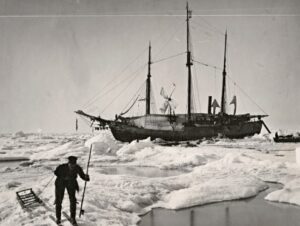
 the first ship to reach the South Pole, during which Fram reached 78° 41′ S.
the first ship to reach the South Pole, during which Fram reached 78° 41′ S.
Following these expeditions, Fram was left to decay in storage from 1912 until the late 1920s. Then, Lars Christensen, Otto Sverdrup, and Oscar Wisting decide to begin an effort to preserve it by starting the Fram Committee. Finally, the now restored ship was installed in the Fram Museum in 1945, where it now stands.

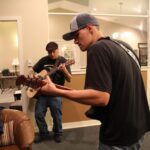 My grandson, Caalab Royce, who lives in Bellingham, Washington, is such a great guy. When Caalab was in middle school, he decided that he wanted to learn to play the guitar. His dad, Travis Royce played the guitar, and Travis was, and still is, Caalab’s hero. So, when the class was offered, he jumped at the chance to actually learn to play, and not just to try to imitate what his dad was doing. Let’s face it, learning to play is much better than stumbling around with it. Which is exactly what any strumming I could do would be called. Caalab has a natural talent though, and I love to listen to him and his dad play. I think they are both very good. They have a little band that practices in his parents’ garage/T&Avern, which is a very cool place named after its owners, Travis and Amy Royce. Of course, when the weather is nice, they practice in the Royce back yard and garden. Either way, I love to listen whenever I am visiting.
My grandson, Caalab Royce, who lives in Bellingham, Washington, is such a great guy. When Caalab was in middle school, he decided that he wanted to learn to play the guitar. His dad, Travis Royce played the guitar, and Travis was, and still is, Caalab’s hero. So, when the class was offered, he jumped at the chance to actually learn to play, and not just to try to imitate what his dad was doing. Let’s face it, learning to play is much better than stumbling around with it. Which is exactly what any strumming I could do would be called. Caalab has a natural talent though, and I love to listen to him and his dad play. I think they are both very good. They have a little band that practices in his parents’ garage/T&Avern, which is a very cool place named after its owners, Travis and Amy Royce. Of course, when the weather is nice, they practice in the Royce back yard and garden. Either way, I love to listen whenever I am visiting.
Caalab has many talents, among them comedy. He always could tell a joke, never forgetting the punch line, 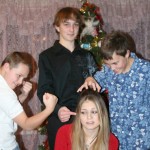
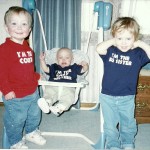 even when he was a little boy, but even more cool is his ability to just be funny. In fact, Caalab hates to be serious. Nevertheless, he has the ability to be serious when it comes to his job as kitchen manager at Red Robin in Bellingham. Let’s face it, kitchen manager at any restaurant is not easy. People in that type of job often don’t want to work. Oh, they want to get paid, but they don’t always want to work for that paycheck. Caalab, as the kitchen manager, has to pick up the slack when one of his kitchen workers doesn’t show up for a shift or when they quit with no notice. It seems to be a common problem in the food industry, no matter what minimum wage is. I think it’s common in many industries. People want a paycheck…but they don’t want a job!!!
even when he was a little boy, but even more cool is his ability to just be funny. In fact, Caalab hates to be serious. Nevertheless, he has the ability to be serious when it comes to his job as kitchen manager at Red Robin in Bellingham. Let’s face it, kitchen manager at any restaurant is not easy. People in that type of job often don’t want to work. Oh, they want to get paid, but they don’t always want to work for that paycheck. Caalab, as the kitchen manager, has to pick up the slack when one of his kitchen workers doesn’t show up for a shift or when they quit with no notice. It seems to be a common problem in the food industry, no matter what minimum wage is. I think it’s common in many industries. People want a paycheck…but they don’t want a job!!!
Caalab has always been a blessing, even if his sister, Shai Royce couldn’t always see the funny side of things, especially when the joke was on her. Nevertheless, these days these two are best friends. Oh, don’t get me wrong, they can argue, but they are still best friends. I always knew they would be, and I told Shai that, but as 
 a young girl, who was always teased by her little brother, she just couldn’t see it. Caalab did love to tease her, but he would have done anything for her too. She was his big sis, and nobody better bother his big sis. For her part, Shai would also do just about anything for her brother too, and she trusts him implicitly, which is quite evident in the fact that for his birthday, she actually bought him a real sword. It is a collector’s sword, but a sword nevertheless, and Caalab thought it was the coolest thing ever. Today is Caalab’s 26th birthday. Happy birthday Caalab!! Have a great day!! We love you!!
a young girl, who was always teased by her little brother, she just couldn’t see it. Caalab did love to tease her, but he would have done anything for her too. She was his big sis, and nobody better bother his big sis. For her part, Shai would also do just about anything for her brother too, and she trusts him implicitly, which is quite evident in the fact that for his birthday, she actually bought him a real sword. It is a collector’s sword, but a sword nevertheless, and Caalab thought it was the coolest thing ever. Today is Caalab’s 26th birthday. Happy birthday Caalab!! Have a great day!! We love you!!

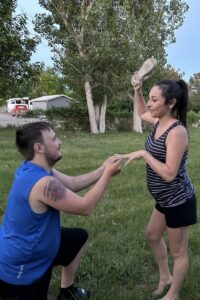 My grandson, Josh Petersen and his fiancée, Athena Salazar met in middle school, and at the time, Athena tells me that she didn’t really like Josh much. That’s not such an odd thing. in those early teen years, everybody feels awkward, and doesn’t really know how to show someone that you like them, and especially for girls, the awkward maneuvering of the teenaged boys makes them someone the girls would rather just avoid. I don’t really know if Josh liked Athena back then, but when they met again, both working at Sanford’s, they knew that things had changed for them. Now before them was a person who was suddenly quite loveable, and they knew that they had found their soulmate for life. Josh and Athena had followed the path of his Grandma and Grandpa Schulenberg, who had known each other all their lives, and for those awkward teen years, she didn’t like him, but then it all changed, and they were together for life. It’s really a sweet story, when you think about it. Today, the story of Josh and Athena is going to the next level.
My grandson, Josh Petersen and his fiancée, Athena Salazar met in middle school, and at the time, Athena tells me that she didn’t really like Josh much. That’s not such an odd thing. in those early teen years, everybody feels awkward, and doesn’t really know how to show someone that you like them, and especially for girls, the awkward maneuvering of the teenaged boys makes them someone the girls would rather just avoid. I don’t really know if Josh liked Athena back then, but when they met again, both working at Sanford’s, they knew that things had changed for them. Now before them was a person who was suddenly quite loveable, and they knew that they had found their soulmate for life. Josh and Athena had followed the path of his Grandma and Grandpa Schulenberg, who had known each other all their lives, and for those awkward teen years, she didn’t like him, but then it all changed, and they were together for life. It’s really a sweet story, when you think about it. Today, the story of Josh and Athena is going to the next level. 
 Today, they will marry the love of their lives. They have been waiting for so long, and they are so excited.
Today, they will marry the love of their lives. They have been waiting for so long, and they are so excited.
We are so happy to have Athena join our family. It is wonderful to see Josh so happy. They couldn’t be more perfect for each other if they tried. They find the same things to be funny, and they love the same things, especially their son, Justin, who was born in 2022 and their little baby boy who will be making his entrance at the end of September. Life is good for these sweet kids, and now it is going to be even sweeter as they become husband and wife. They have so many good things ahead of them and this is just the beginning, the point when two lives who have known each other for so long, 
 and now become one.
and now become one.
Josh and Athena have so much in common, from school days to work, to their likes and dislikes, and their temperaments. They are the kind of people who are always willing to help others, and that endears them to many people. They like to travel and see new places, but they enjoy hanging out at home just as much. Their son, Justin and soon his little brother, Axel are their top priorities, and they love them both so much. They are already such great parents, and so great as a couple, and I know they will be equally as great as husband and wife. Today is the day…their Wedding Day!! Congratulations Athena and Josh!! Congratulations on your marriage!! We are so happy for you both!! We love you!!

 My grandniece, Maya Stevens is such a happy baby girl. She loves playing with her big sister, Elliott Stevens, who very much loves to entertain her little sister. Maya love learning new things. She was just playing with a walker toy and didn’t even realize that she really was walking and walking well. She also stands alone for 10 to 20 seconds before she realizes what she is doing. That’s how it goes with children. If the learning is made to be like play, they learn quickly. It’s the nature of babies and children. Maya loves her parents, Kayla and Garrett Stevens, so much. They are her favorite people. She also loves her grandparents, Alena and Mike Stevens and Lynette and Wes Smiley, very much. She also loves her cousins, especially Brooklyn Killinger, whom she
My grandniece, Maya Stevens is such a happy baby girl. She loves playing with her big sister, Elliott Stevens, who very much loves to entertain her little sister. Maya love learning new things. She was just playing with a walker toy and didn’t even realize that she really was walking and walking well. She also stands alone for 10 to 20 seconds before she realizes what she is doing. That’s how it goes with children. If the learning is made to be like play, they learn quickly. It’s the nature of babies and children. Maya loves her parents, Kayla and Garrett Stevens, so much. They are her favorite people. She also loves her grandparents, Alena and Mike Stevens and Lynette and Wes Smiley, very much. She also loves her cousins, especially Brooklyn Killinger, whom she  will totally hang out with for hours. Of course, she loves Brooklyn’s brother, Jaxxon Killinger too. He makes her laugh.
will totally hang out with for hours. Of course, she loves Brooklyn’s brother, Jaxxon Killinger too. He makes her laugh.
Maya is learning so many new things. She loves kids, but Brooklyn and Elliott are her favorites. She is in that “I don’t like strange adults” stage right now…especially men, and she is very aware of where her mom and Dad are at all times. If they leave the room, Maya knows it. That is rather a common thing among one-year-old children. They just don’t feel comfortable with people they don’t know well. I think its a good thing actually. Maya is crawling around all over the place and getting into stuff. That could be bad, but the house is already kid-proof, so it’s ok. When Maya gets into the pans, it’s time for the “one girl band” to play. She bangs the pans 
 and makes as much noise as she can. She likes banging on pans or anything that makes a loud noise…to the delight of her parents…I’m sure. She loves to play in the water, especially when her daddy makes sure she gets wet.
and makes as much noise as she can. She likes banging on pans or anything that makes a loud noise…to the delight of her parents…I’m sure. She loves to play in the water, especially when her daddy makes sure she gets wet.
Maya doesn’t have any teeth yet, but her mom is sure they will be popping through any day now. Kayla often sends out videos to friends and family so we can see the antics of Elliott and Maya!! We all love to see them very much. The girls are just precious, and they bring joy to anyone who knows them…especially their parents. Maya goes to daycare these days, and the daycare ladies absolutely love her. They are always telling her parents just how sweet she is. Today is Maya’s first birthday. Happy birthday Sweet Maya!! Have a great day!! We love you!!
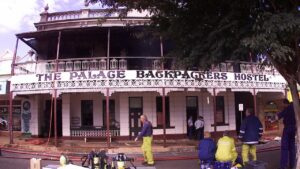
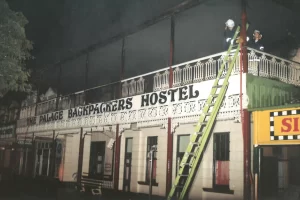 Hiking and Backpacking have been a favorite pastime for many people for many years, and some people go to greater lengths and distances than others. Backpacking in Australia is a trip on the bucket lists of a lot of people. On their hikes, many people have made the Childers Palace Backpackers Hostel one of their stops. Located in the former Palace Hotel in the town of Childers, Queensland, Australia, the building had been converted into a backpacker hostel. That was the stop for 15 backpackers on June 22, 2000. They had been hiking all day and were ready for some downtime. After a relaxed evening, they all went to bed. There were 88 people staying in the building that night, but the building could house 101 people.
Hiking and Backpacking have been a favorite pastime for many people for many years, and some people go to greater lengths and distances than others. Backpacking in Australia is a trip on the bucket lists of a lot of people. On their hikes, many people have made the Childers Palace Backpackers Hostel one of their stops. Located in the former Palace Hotel in the town of Childers, Queensland, Australia, the building had been converted into a backpacker hostel. That was the stop for 15 backpackers on June 22, 2000. They had been hiking all day and were ready for some downtime. After a relaxed evening, they all went to bed. There were 88 people staying in the building that night, but the building could house 101 people.
At about 12:30am on June 23, 2000, a fire started in the downstairs recreation room and quickly spread up the walls and into the stairwell. The first emergency call came from a pay phone across the street, and it was logged at 12:31am. Emergency services first arrived at 12:38am and spent four hours battling the fire before it was fully extinguished. In the aftermath, it was found that 15 backpackers, nine women and six men, had lost their lives. Survivors told of how smoke quickly filled the area and how the building’s power was lost. They struggled in the darkness to find a way out, and in the absence of alarms and emergency lighting, some people attempted to awaken and rescue as many people as they could. Of the 70 backpackers who survived the fire, 10 suffered minor burns and injuries as they tried to escape from the upper level and by jumping onto the roofs of the neighboring buildings. In this fire, those who got out lived, those who died did not get out at all.
Of the 15 who died in the fire, seven were British, three were Australian, two were from the Netherlands, and one each from Ireland, Japan, and South Korea. It took a while to identify the dead, because there was an incomplete hostel register. It recorded check-ins, but unfortunately not departures. To further complicate things, most of the residents’ passports were destroyed or damaged by the fire. DNA samples were also difficult to obtain for those with no relatives in Australia. Most of the backpackers who died were on the first floor of the hostel. Through an inquest, it was found that in one of the upper rooms where 10 victims were found, which was all of the occupants of that room, a bunk bed blocked a fastened exit door, and the windows were barred. They had little chance of escape.
It was found that a fruit packer named Robert Paul Long, had moved into the hostel on March 24, 2000, but had been evicted on June 14, 2000, over a matter of $200 rent in arrears. Long didn’t leave the area, as was seen in ATM records that showed him in the area in the week before the fire. Long, who had expressed a hatred of backpackers, had also earlier threatened to burn down the hostel. Around midnight, prior to the fire, two guests saw Long in the back yard of the hostel. Long had asked them to leave the door open so he could assault his former roommate, an Indian national. They declined, and he told them that he still had a key. Another guest recounted how he had woken up around midnight to find Long downstairs using a PC near a burning rubbish bin. After the guest protested the reckless actions, Long took the bin outside, and the guest went back to bed, but was awakened later to banging sounds, shouting, and thick black smoke.
After the fire, Long tried to mask his movements, but he was later spotted in cane-fields about five days later. At that time, he was arrested in bush-land near Howard, which is less than 20 miles from Childers. As he was being arrested, Long stabbed a police dog after being bitten. Then, he stabbed one of the officers in the jaw and the second officer shot Long in the shoulder. In March of 2002, Long was found guilty of two charges of murder (for the dead Australian twins) and arson and sentenced to life in prison. While it seems strange to only charge him with the deaths of two of the 15 victims, it was thought that it would expedite the proceedings and to allow for other charges to be brought in the event of an acquittal. Following his conviction, Long filed an appeal in 2002, which was denied. In June 2020 he became eligible for parole, but his February 2021 parole appeal was rejected. He could become eligible again in 1 year.
After the fire, and many people losing everything they owned, survivors were temporarily housed locally at the Isis Cultural Centre. Japan’s embassy officials quickly evacuated five Japanese nationals, which eased things a little. Residents of Childers knitted blankets and donated food and backpacks for the survivors. Residents also invited survivors for meals and showers and local businesses assisted with food, clothing, and personal items. Media, politicians, and investigators came to the site as well and Princess Anne visited on July 2nd, to meet the surviving backpackers and others involved in the disaster.
The results of a coronial inquest were released in 2006. “The hostel, a 98-year-old, two-story timber building, did not have working smoke detectors or fire alarms. It was later reported that the owner had installed fire alarms in the building, but they had been disabled weeks prior to the fire due to regular malfunctioning. It was also mentioned that batteries for the stand-alone alarms were sometimes removed by customers for portable cameras or music players.” When it was announced that the coroner had decided not to charge the owner and operators of the hostel for negligence, families of seven victims filed a class action suit against them.
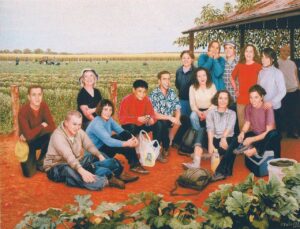
 On October 26, 2002, the renovated structure, renamed the Palace Memorial Building, opened and the opening ceremony was attended by some 250 invited guests, including members of 12 of the families of those who died. Frank Slarke, the father of the dead Australian twins, read a poem he wrote as a eulogy. Since then, over one million visitors have visited the building.
On October 26, 2002, the renovated structure, renamed the Palace Memorial Building, opened and the opening ceremony was attended by some 250 invited guests, including members of 12 of the families of those who died. Frank Slarke, the father of the dead Australian twins, read a poem he wrote as a eulogy. Since then, over one million visitors have visited the building.
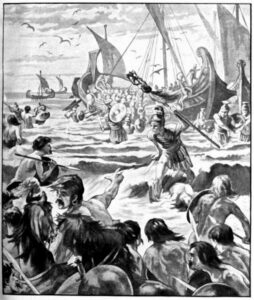
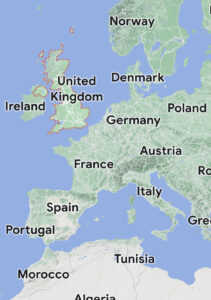 Before Julius Caesar invaded Britain, many Romans didn’t believe it existed. Julius Caesar was the first-ever Roman to invade Britain. He did it twice in the years 55 and 54 BC. Some Romans believed Britain to be just the foot of another huge northern continent. Others thought it was a place full of unbelievable riches, whilst most thought it just didn’t exist.
Before Julius Caesar invaded Britain, many Romans didn’t believe it existed. Julius Caesar was the first-ever Roman to invade Britain. He did it twice in the years 55 and 54 BC. Some Romans believed Britain to be just the foot of another huge northern continent. Others thought it was a place full of unbelievable riches, whilst most thought it just didn’t exist.
In the course of his Gallic Wars, Julius Caesar invaded Britain twice: in 55 and 54 BC. On the first occasion Caesar took with him only two legions and achieved little beyond a landing on the coast of Kent. The second invasion consisted of 628 ships, five legions and 2,000 cavalry. The Roman legion is the largest military unit of the Roman army,  comprised 5,200 infantry and 300 equites (cavalry) in the period of the Roman Republic (509 BC–27 BC) and 5,600 infantry and 200 auxilia in the period of the Roman Empire (27 BC – AD 476). Caesar’s force was so overwhelming that the Britons did not dare contest Caesar’s landing in Kent, waiting instead until he began to move inland. Caesar’s forces eventually made their way into Middlesex and crossed the Thames, forcing the British warlord Cassivellaunus to surrender, after which Caesar set up Mandubracius of the Trinovantes as client king, basically a sub king. As with all conquerors, Caesar included the accounts of both invasions in his Commentarii de Bello Gallico, with the first significant first-hand description of the people, culture, and geography of the island.
comprised 5,200 infantry and 300 equites (cavalry) in the period of the Roman Republic (509 BC–27 BC) and 5,600 infantry and 200 auxilia in the period of the Roman Empire (27 BC – AD 476). Caesar’s force was so overwhelming that the Britons did not dare contest Caesar’s landing in Kent, waiting instead until he began to move inland. Caesar’s forces eventually made their way into Middlesex and crossed the Thames, forcing the British warlord Cassivellaunus to surrender, after which Caesar set up Mandubracius of the Trinovantes as client king, basically a sub king. As with all conquerors, Caesar included the accounts of both invasions in his Commentarii de Bello Gallico, with the first significant first-hand description of the people, culture, and geography of the island. 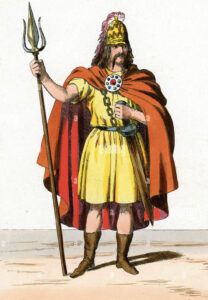
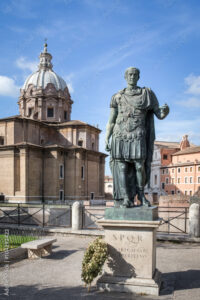 Caesar’s writings are thought to be the start of the written history or at least the protohistory of Britain.
Caesar’s writings are thought to be the start of the written history or at least the protohistory of Britain.
It seems odd to me to think that people could simply not think that Britain exists, but I suppose that in a huge part of our world’s history, and actually still with some people today, it was thought that the Earth is flat, meaning that the horizon we see is all there is. If that is your mindset, it would be easy to limit the Earth to the horizon we can see, but it would not be an assumption that would be based on fact. Now with satellites and airplanes we know that the Earth is definitely round, just like the Bible and most people have said. And that said, we know that Britain existed long before the men of Caesar’s time found and invaded.

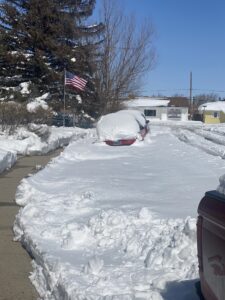 Normally, on this first day of Summer, I would be thinking about the days coming up, the precious few days when I finally get to feel the warmth that doesn’t come from being wrapped in a blanket or wearing a coat. Yes, Summer can be sweltering, and I can find myself wishing for a little cooler temperature, but I don’t want it to be much cooler. I am a summer person. I like heat. I like wearing shorts and sandals, rather than sweaters and coats.
Normally, on this first day of Summer, I would be thinking about the days coming up, the precious few days when I finally get to feel the warmth that doesn’t come from being wrapped in a blanket or wearing a coat. Yes, Summer can be sweltering, and I can find myself wishing for a little cooler temperature, but I don’t want it to be much cooler. I am a summer person. I like heat. I like wearing shorts and sandals, rather than sweaters and coats.
This year is a rather odd year…not that we haven’t had years of unusual weather…and no, I don’t buy into the whole global warming, climate change, or whatever they are calling it these days. Weather had natural patterns that have existed since time began, and this is nothing new. Nevertheless, when we have one of those years of an unusually cold Spring, and unusually harsh Winter, and somehow a fairly normal Fall, I find myself waiting for normalcy, impatiently!!
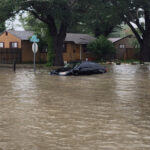
 This has been one of those years, and I’m ready for the end of Spring. Our Winter was harsh, with lots of snow and this Spring has been full of thunderstorms and pouring rain…to the point of flash flooding and lots of warnings for lightning, hail, tornadoes, and floods. Those things aren’t all that unusual, with the possible exception of the floods, but the thing I really noticed was the cold temperatures. Normally as we approach the end of June, I am wearing shorts and t-shirts when I go out for my early morning walk. This year, however, I have been wearing pants and a jacket to keep me warm. Of course, by the time I am almost finished, I’m warm enough to go without a jacket…except for the clouds. Clouds just keep things cooler.
This has been one of those years, and I’m ready for the end of Spring. Our Winter was harsh, with lots of snow and this Spring has been full of thunderstorms and pouring rain…to the point of flash flooding and lots of warnings for lightning, hail, tornadoes, and floods. Those things aren’t all that unusual, with the possible exception of the floods, but the thing I really noticed was the cold temperatures. Normally as we approach the end of June, I am wearing shorts and t-shirts when I go out for my early morning walk. This year, however, I have been wearing pants and a jacket to keep me warm. Of course, by the time I am almost finished, I’m warm enough to go without a jacket…except for the clouds. Clouds just keep things cooler.

 As I was walking these past few mornings, I thought about just how much cooler it had been this Spring, and I hoped that as the Summer arrived, it would finally begin to warm up. I also thought about another Summer about 20 years ago or so. The Spring had been cold that year too, and Summer hadn’t improved much. In fact, it was the coldest Summer I had ever remembered. Infact, it was as if Summer never arrived that year. That makes for the feeling of a long cold Winter, even though there were some warm days. The good thing about the colder rainy weather, however, was that the grass, and several other things grew better that they had in years. I guess that’s a plus, but if you don’t mind, I’ll take the warmer weather, with the leaves on the trees and the deer by the trail. Those things make my whole day.
As I was walking these past few mornings, I thought about just how much cooler it had been this Spring, and I hoped that as the Summer arrived, it would finally begin to warm up. I also thought about another Summer about 20 years ago or so. The Spring had been cold that year too, and Summer hadn’t improved much. In fact, it was the coldest Summer I had ever remembered. Infact, it was as if Summer never arrived that year. That makes for the feeling of a long cold Winter, even though there were some warm days. The good thing about the colder rainy weather, however, was that the grass, and several other things grew better that they had in years. I guess that’s a plus, but if you don’t mind, I’ll take the warmer weather, with the leaves on the trees and the deer by the trail. Those things make my whole day.
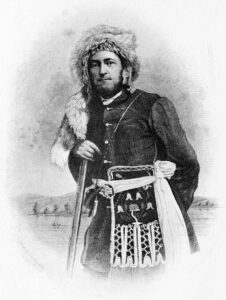 Joe Meek was born in Virginia in 1810. He was a friendly young man, with a great sense of humor, but he had too much rambunctious energy to do well in school. He just couldn’t sit still well enough to focus on his studies. Finally, at 16 years old and illiterate, Meek gave up on school and moved west to join two of his brothers in Missouri. Still, he didn’t give up on all of his learning, just the formal learning. In later years, he taught himself to read and write, but his spelling and grammar remained “highly original” throughout his life.
Joe Meek was born in Virginia in 1810. He was a friendly young man, with a great sense of humor, but he had too much rambunctious energy to do well in school. He just couldn’t sit still well enough to focus on his studies. Finally, at 16 years old and illiterate, Meek gave up on school and moved west to join two of his brothers in Missouri. Still, he didn’t give up on all of his learning, just the formal learning. In later years, he taught himself to read and write, but his spelling and grammar remained “highly original” throughout his life.
Meek seemed to flourish in the West. It appears that he had found his calling, and in early 1829, he joined William Sublette’s ambitious expedition to begin fur trading in the Far West. Meek traveled throughout the West for the next decade. For him there was nothing greater than the adventure and independence of the mountain man life. Meek, the picture of a mountain man, at 6 feet 2 inches tall, and heavily bearded became a favorite character at the annual mountain-men rendezvous. The others loved to listen to his humorous and often exaggerated stories of his wilderness adventures. The truth is, I’m sure many people would have loved to hear about the adventures of the mountain man, especially this one, who was so unique. Like most mountain men, Meek was a renowned grizzly bear hunter. I suppose his stories of his hunting escapades could have been exaggerations, it’s hard to say. Meek claimed he liked to “count coup” on the dangerous animals before killing them, a variation on a Native American practice in which they shamed a live human enemy by tapping them with a long stick. To tap a grizzly bear with a stick, before the attempted kill, took either courage…or stupidity. Meek also claimed that he had wrestled an attacking grizzly with his bare hands before finally sinking a tomahawk into its brain. I suppose that if a grizzly bear attacked you, you would have no choice but to fight for your life, with your bare hands. Having the forethought to go for your tomahawk would be…well, amazing. Most people would try to cover their heads, and hope for the best. Still, that wouldn’t do much good. In a bear attack, you had better fight with everything you have, if you want to live. Maybe 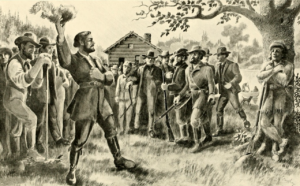 mountain men spent a lot of time considering the possibility of an attack, and practicing in their head exactly how they would handle it.
mountain men spent a lot of time considering the possibility of an attack, and practicing in their head exactly how they would handle it.
Meek soon established good relations with many Native Americans, effectively melding with the Indians. He even married three Native American women, including the daughter of a Nez Perce chief. Now, that didn’t mean that he didn’t fight with the tribes on occasion, or at least the tribes who were hostile to the incursion of the mountain men into their territories. Meek intended to fight for his right to be on the land, the same as the Indians. In the spring of 1837, Meek was nearly killed by a Blackfeet warrior who was taking aim with his bow while Meek tried to reload his Hawken rifle. In the end, the warrior nervously dropped his first arrow while drawing the bow, and Meek had time to reload and shoot. The warrior’s fumble cost him his life, while saving Meek’s life.
After a great run as a mountain man, Meek recognized that the golden era of the free trappers was coming to a close. He began making plans to find another form of income. He joined with another mountain man, and along with his third wife, he guided one of the first wagon trains to cross the Rockies on the Oregon Trail. Once he arrived in Oregon, Meek fell in love with the lush Willamette Valley of western Oregon. He settled down and became a farmer, and actively encouraged other Americans to join him. Of course, more White men on what had been Indian lands, came with safety issued. Meek led a delegation to Washington DC to ask for military protection from Native American attacks and territorial status for Oregon in 1847. Though he arrived “ragged, 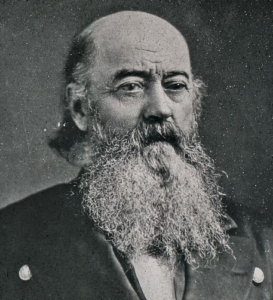 dirty, and lousy,” Meek became a bit of a celebrity in the capitol. Not used to the ways of mountain men, the Easterners truly enjoyed the rowdy good humor Meek showed in proclaiming himself the “envoy extraordinary and minister plenipotentiary from the Republic of Oregon to the Court of the United States.” His enthusiasm prompted Congress to making Oregon an official American territory and Meek a US marshal. I wonder if he was shocked by his new role.
dirty, and lousy,” Meek became a bit of a celebrity in the capitol. Not used to the ways of mountain men, the Easterners truly enjoyed the rowdy good humor Meek showed in proclaiming himself the “envoy extraordinary and minister plenipotentiary from the Republic of Oregon to the Court of the United States.” His enthusiasm prompted Congress to making Oregon an official American territory and Meek a US marshal. I wonder if he was shocked by his new role.
He might have been shocked, but Meek embraced his new role. He returned to Oregon and became heavily involved in politics, eventually founded the Oregon Republican Party. After his years of service, he retired to his farm, and on June 20, 1875, at the age of 65, Meek passed away. With his passing the world lost a skilled practitioner of the frontier art of the tall tale. It is said that his life was nearly as adventurous as his stories claimed, but there is no sure line to tell what was real and what was tall tale.
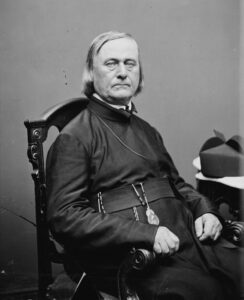 As the United States was being settled, a number of wars were fought between the Native Americans and the White Man. So much anger and so many hard feelings had passed between the two groups that it seemed like peace could never be achieved. Finally, in an attempt to convince local Native Americans to make peace with the United States, the Jesuit missionary Pierre-Jean De Smet met with the Sioux leader Sitting Bull in what is present-day Montana. He saw an urgent need to make peace and decided to go for it.
As the United States was being settled, a number of wars were fought between the Native Americans and the White Man. So much anger and so many hard feelings had passed between the two groups that it seemed like peace could never be achieved. Finally, in an attempt to convince local Native Americans to make peace with the United States, the Jesuit missionary Pierre-Jean De Smet met with the Sioux leader Sitting Bull in what is present-day Montana. He saw an urgent need to make peace and decided to go for it.
De Smet was a native of Belgium, who came to the United States in 1821 at the age of 20. Once in the states, he became a novice of the Jesuit order in Maryland. De Smet was ordained in Saint Louis, and as a priest, decided to be a missionary to the Native Americans of the Far West. It was an ambitious goal, but in 1838, he was sent to evangelize the Potawatomi villages near present-day Council Bluffs, Iowa. De Smet met a delegation of Flathead Indians there. The Indians had come east looking for a “black robe” whom they hoped might be able to aid their tribe. Of course, a “black robe” would be a priest, and since De Smet was indeed a priest, they had found what they were looking for. De Smet worked with the Flathead Indians several times during the 1840s in present-day western Montana. While there, he established a mission and actually secured a peace treaty with the Blackfeet, who had previously been the irreconcilable enemy of the Flathead.
His hard work earned De Smet a reputation as a white man who could be trusted to negotiate disputes between Native Americans and the US government, which was not something that very many people could boast. The disputes between the Indians and the US government became fairly commonplace in the West during the 1860s. The Plains Indians, like the Sioux and Cheyenne resisted the growing flood of white settlers invading their territories and killing their game animals. As the conflicts continued, the US government began to demand 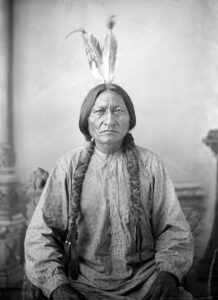 that all the Plains Indians be relocated to reservations, another source of contention. The leaders in the American government and military had hoped that the relocation could be achieved through negotiations, but in the absence of a peaceful relocation, they were perfectly willing to use violence to force the local Native Americans to comply. It was futile to fight the change, but anyone can see why the Native Americans would try. They didn’t want to be forced to stay in just one area and to be told what they could and could not do…and in reality, the reservations have not proven to be the best thing for either side. Nevertheless, that is where we are today, and in many ways, the situation hasn’t improved much, except there aren’t Indian wars, so I guess that is a good thing. The disputes are handled differently now, but the feeling of a nation inside a nation is one that really isn’t perfect. Still, the Indian Nation does exist inside the United States, and they do have jurisdiction in their own territory, and I don’t suppose the feeling of separation will ever change.
that all the Plains Indians be relocated to reservations, another source of contention. The leaders in the American government and military had hoped that the relocation could be achieved through negotiations, but in the absence of a peaceful relocation, they were perfectly willing to use violence to force the local Native Americans to comply. It was futile to fight the change, but anyone can see why the Native Americans would try. They didn’t want to be forced to stay in just one area and to be told what they could and could not do…and in reality, the reservations have not proven to be the best thing for either side. Nevertheless, that is where we are today, and in many ways, the situation hasn’t improved much, except there aren’t Indian wars, so I guess that is a good thing. The disputes are handled differently now, but the feeling of a nation inside a nation is one that really isn’t perfect. Still, the Indian Nation does exist inside the United States, and they do have jurisdiction in their own territory, and I don’t suppose the feeling of separation will ever change.
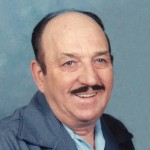
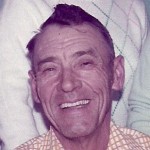 I always greet Father’s Day with mixed emotions. I don’t have my dad, Allen Spencer or my father-in-law, Walt Schulenberg with me anymore, so there is always a little bit of sadness too, because I miss them both so much. They were both so important to me…they still are, but now they are in Heaven, and in my future. Nevertheless, on this and every day, I think of them lovingly, because they were so influential in my life. God blessed me, my husband, and siblings with two of the greatest dads ever. Both were gentle souls, soft spoken and kind, and both were hard workers. Sometimes, the similarities surprised me, but I always knew that I was loved and valued.
I always greet Father’s Day with mixed emotions. I don’t have my dad, Allen Spencer or my father-in-law, Walt Schulenberg with me anymore, so there is always a little bit of sadness too, because I miss them both so much. They were both so important to me…they still are, but now they are in Heaven, and in my future. Nevertheless, on this and every day, I think of them lovingly, because they were so influential in my life. God blessed me, my husband, and siblings with two of the greatest dads ever. Both were gentle souls, soft spoken and kind, and both were hard workers. Sometimes, the similarities surprised me, but I always knew that I was loved and valued.
When I met and married my husband, Bob Schulenberg, God gave me a perfect soulmate. Bob took after his dad is so many ways, not the least of which, was his work ethic. They had spent countless hours together working on cars and other projects around his dad and mom’s place. They probably spent just as much time 

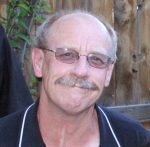 working on our stuff too. Bob was a “girl-dad” and a very good one. Our girls had him wrapped around their little pinky, and he was just fine with that. He was like his dad in so many ways, and that soft heartedness followed him into fatherhood. The girls could have gotten away with just about anything, because like his dad, Bob was a softie.
working on our stuff too. Bob was a “girl-dad” and a very good one. Our girls had him wrapped around their little pinky, and he was just fine with that. He was like his dad in so many ways, and that soft heartedness followed him into fatherhood. The girls could have gotten away with just about anything, because like his dad, Bob was a softie.
Now our girls are both married to wonderful men, Kevin Petersen and Travis Royce, and we consider ourselves very blessed to have both of these wonderful sons-in-law in our lives too. It is so great to be able to give your daughter in marriage, knowing that the man she is marrying is going to treat her well, provide for her, and take care of her. The years have brought many changes into our girls’ lives, and their husbands have been beside 
 them all the way. they have given us a beautiful granddaughter, and three handsome grandsons, who have all blessed our lives greatly. And now, two of our grandsons are dads too. Chris (Karen) Petersen and Josh (Athena Salazar, soon to be Petersen) Petersen. The next generation of babies have brought us a great granddaughter, Cambree Petersen, two grandsons, Caysen Petersen and Justin Petersen, and two more grandsons on the way. Life is good!! Happy Fathers’ Day to all of the dads in my life, and to all of the other dads out there. Have a wonderful day and know that you are loved and appreciated very much!!
them all the way. they have given us a beautiful granddaughter, and three handsome grandsons, who have all blessed our lives greatly. And now, two of our grandsons are dads too. Chris (Karen) Petersen and Josh (Athena Salazar, soon to be Petersen) Petersen. The next generation of babies have brought us a great granddaughter, Cambree Petersen, two grandsons, Caysen Petersen and Justin Petersen, and two more grandsons on the way. Life is good!! Happy Fathers’ Day to all of the dads in my life, and to all of the other dads out there. Have a wonderful day and know that you are loved and appreciated very much!!

